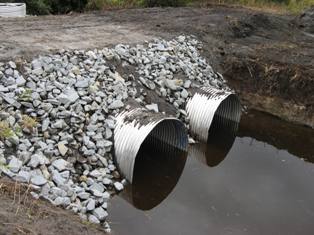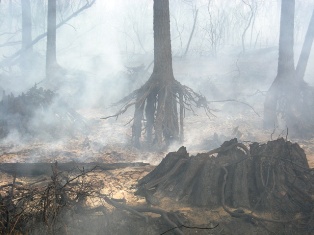Pocosin Lakes NWR 2009
In March 2009, DU completed construction at Pocosin Lakes National Wildlife Refuge under an existing agreement with the US Fish and Wildlife Service. A combination of 49 water control structures and culverts were used to improve water delivery at Pocosin Lakes NWR, impacting 13,500 acres of unique pocosin habitat in Hyde, Tyrrell and Washington Counties in North
 |
| New water control structure at Pocosin Lakes NWR. |
Carolina. A pocosin is a type of freshwater wetland characterized by nutrient-deficient soils composed of shallow or deep peat, sometimes referred to as "shrub bogs". Pocosin Lakes NWR hosts large concentrations of migratory birds during winter, especially ducks and tundra swans. The refuge is home to an abundant black bear population and is a re-introduction site for the endangered red wolf.
The project greatly enhanced the ability of refuge staff to provide wildfire protection and suppression by increasing water delivery capabilities. Historically, a large portion of the refuge was ditched and drained, then cleared to support farming. The altered state of the soils made the lands more susceptible to intense wildfires during periods of hot, dry weather.
An example of such a fire occurred on June 1, 2008, when the Evans Road Fire began as a result of a lightning strike on private land south of Pocosin Lakes NWR. Seven months later, on January 5, 2009, Pocosin Lakes NWR Fire Management Officer Vince Carver declared the Evans Road Fire to be officially out.
Putting out the fire burning underground in dry peat soil was one of the greatest challenges for firefighters. Over 2 billion gallons of water were pumped from Lake Phelps,
 |
| Evans Road Fire - note stilted tree due to burned peat. (photo: USFWS) |
New Lake and the NW and SW Forks of the Alligator River. Using additional high-volume pumps, the water was then moved over 35 miles to the most severe areas to prevent the fire from spreading. Standing water was used to help cool the peat burning deep underground on the Evans Road Fire - the only way to effectively suppress fires burning in peat soils typical of Pocosin Lakes NWR.
Because of the fire's size, it would have been impractical, if not impossible, to flood the entire area. But the pumping efforts, in combination with some heavy late-summer rains, extinguished most of the peat fire. The fire burned a total of 40,704 acres of land, with 60% of the acreage on refuge property.
Countless tons of peat were consumed by the fire, and suppression efforts cost just under $20 million. On a brighter note, small depressions may have been created the where the wildfire burned deep into the peat. These newly created wetlands will provide important habitat for waterfowl and other wildlife.
Contact:
Tye Anderson
Regional Biologist
843.745.9110
tanderson@ducks.org
Ducks Unlimited uses cookies to enhance your browsing experience, optimize site functionality, analyze traffic, and deliver personalized advertising through third parties. By continuing to use this site, you agree to our use of cookies. View Privacy Policy